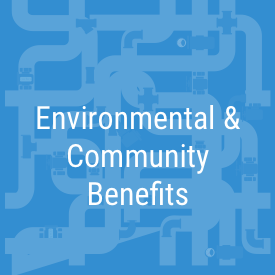This project allows Valley Water to remove non-native, invasive plants and revegetate habitat with native species when needed. Funding also restores degraded habitat between revegetated sites to create a more contiguous habitat corridor for wildlife. This project includes targeted control of especially damaging non-native, invasive plant species such as Arundo donax, and education for nearby landowners and other stakeholder groups on the control of harmful species. This project also helps implement the Stream Corridor Priority Plans developed in Project D3.








Key Performance Indicators for the Safe, Clean Water Program
Through June 2020, approximately 79 acres of non-native, invasive plants have been removed above Lexington Reservoir, Lower Guadalupe River, Stevens Creek, Saratoga Creek, South San Francisco Bay and Coyote Creek (approximately 11 acres by Valley Water and approximately 68 acres under KPI #2 partnerships).
KPI #1: Revitalize at least 21 acres, guided by the 5 Stream Corridor Priority Plans, through native plant revegetation and removal of invasive exotic species.
- Controlled invasive plants along 2.2 acres of Stevens Creek and 5.5 acres of Saratoga Creek in coordination with the Valley Water's Stream Maintenance Program (SMP)
- Completed 0.5 acres of non-native tree, shrub and vine removals along the Guadalupe River in addition to 2.0 acres completed under a Clean, Safe Creeks and Natural Flood Protection grant. View maps of pre-revitalization non-native and invasive plant cover prior to removal:
- Restored 0.5 acres of oak woodland habitat in Coyote Valley via removal of non-native vegetation and planting of valley oaks. The project enhances the habitat value of this site, which is a known wildlife corridor approach to a Highway 101 undercrossing that connects the Santa Cruz Mountains to the Diablo Range to the east:
KPI #2: Provide funding for revitalization of at least 7 of 21 acres through community partnerships.
- Established partnerships with the Midpeninsula Regional Open Space District (Midpen) in July 2017, California State Coastal Conservancy in January 2018, and the City of San José in March 2018.
- Midpen is working to bring back the native landscapes and biodiversity that once thrived on the Bear Creek Redwoods Open Space Preserve above Lexington Reservoir. Volunteers removed harmful invasive plants along its creeks to improve habitat for rare wildlife. Click here for a map showing where over 63 acres of work has been done through June 2020.
- Controlled nearly 5 acres of smooth cordgrass (Spartina alternflora), some originally under a Clean, Safe Creeks and Natural Flood Protection grant, in partnership with the Coastal Conservancy and Invasive Spartina Project.
- Working cooperatively with the City of San José on Coyote Creek in response to the 2017 flood. Valley Water's SMP removed some of the giant reed (Arundo donax) for the City on Coyote Creek at Oakland Road. The City and its contractors are continuing giant reed clearing and native habitat restoration at this location.
- Formed the Santa Clara County Wildlife Corridors Working Group with US Fish and Wildlife Services (USFWS), California Department of Fish and Wildlife (CDFW), CalTrans, Santa Clara Valley Transportation Authority (VTA), Santa Clara County Parks, Santa Clara Valley Habitat Agency, Peninsula Open Space Trust (POST), Open Space Authority (OSA), The Nature Conservancy (TNC), De Anza College, and others.
KPI #3: Develop at least 2 plant palettes for use on revegetation projects to support birds and other wildlife.
Completed 5 plant palettes for revegetation projects, landscaping and native gardens with links to use by birds, bees, butterflies, and wildlife.
-
Native freshwater marsh and wet meadow plants of the Santa Clara Valley
-
Native tidal marsh and transition or ecotone plants of South San Francisco Bay
-
Plants native to Santa Clara County for bees and butterflies
See the Reports & Documents tab for more on invasive plants, native landscapes and gardens.
Updated April 2021
Related information
-
CA Invasive Plant Council (Cal-IPC) - scroll down to the middle of Cal-IPC’s home page for science-based tools and information to help make the best choices for CA.
-
Calflora - an abundance of information on California plants.
-
SFEI’s historical ecology studies for Santa Clara County - shows past and present habitats, and environmental conditions important for habitat revitalization.
-
Sycamore Alluvial Woodland Planting Guide (Loma Prieta RCD, SFEI, and HT Harvey 2018).
-
Sycamore Alluvial Woodland: Habitat mapping and regeneration study (Beagle et al., 2017 SFEI).
-
Re-Oaking - CA oaks and other native trees (SFEI).
-
Resilient Silicon Valley - improving ecosystem health (SFEI).
- Urban Ecological Planning Guide for Santa Clara Valley by SFEI (2019).
- Santa Clara County Wildlife Corridors Working Group recommendations to reduce wildlife-vehicle collisions on the Monterey Road corridor in Coyote Valley
-
NBC Bay Area OpenRoad with Doug McDonnell Coyote Valley Wildlife Corridor.
-
Calscape by CNPS - native butterflies & moths by location, including host plants.
-
What Grows Here by Calflora
Methods to control invasive plants
- Cal-IPC Invasive Plant Management references including Invasive Plants of California's Wildlands (Bossard et al. 2000).
-
Practical Guidebook for the Identification and Control of Invasive Aquatic and Wetland Plants (SFEI)
Water mold alerts
Phytophthora species are pathogenic water molds affecting our native plants. For more information, go to Why the concern (2015), CNPS and below.
-
CalPhytos Phytophthoras in native plants.
-
Sudden oak death – California Oak Mortality Task Force
-
Phytophthora pathogens threaten rare habitats and conservation plantings (Frankel et al. 2020).
-
Valley Water hosted symposiums:
Record, Track and Monitor Weeds
-
Calflora’s Weed Manager (WM) is a system which enables organizations engaged in land management to track weed infestations and treatments over time.
Native Plant Gardens
- Valley Water’s Landscape Rebate Program
-
California Native Plant Society (CNPS) and its Santa Clara Valley Chapter.
Updated February 2021
Key Performance Indicators for the Safe, Clean Water Program
-
Revitalize at least 21 acres, guided by the 5 Stream Corridor Priority Plans, through native plant revegetation and removal of invasive exotic species.
-
Provide funding for revitalization of at least 7 of 21 acres through community partnerships.
-
Develop at least 2 plant palettes for use on revegetation projects to support birds and other wildlife.
Benefits
-
Increases viability of native riparian species by reducing competition from non-native, invasive species
-
Improves habitat by installing tidal and riparian plant species
-
Improves ecological function of existing riparian and wetland habitats to support more diverse wildlife species
-
Improves patchy wildlife corridors by increasing connectivity of habitat
-
Increases community awareness about the damaging impact that non-native, invasive plants have on local ecosystems
Geographic Area of Benefit
Countywide
About the Safe, Clean Water and Natural Flood Protection Program
In November 2012 the voters of Santa Clara County overwhelmingly approved Measure B, the Safe, Clean Water and Natural Flood Protection Program, as a countywide special parcel tax for 15 years with a sunset date of June 30, 2028. This Program replaced the Clean, Safe Creeks and Natural Flood Protection Plan, which voters approved in November 2000.
The Safe, Clean Water Program was developed with input from more than 16,000 residents and stakeholders and was created to match the community’s needs and values. The voters of Santa Clara County identified five priorities:
Priority A: Ensure a Safe, Reliable Water Supply
Priority B: Reduce Toxins, Hazards and Contaminants in our Waterways
Priority C: Protect our Water Supply from Earthquakes and Natural Disasters
Priority D: Restore Wildlife Habitat and Provide Open Space
Priority E: Provide Flood Protection to Homes, Businesses, Schools and Highways
Other: Six projects from the Clean, Safe, Creeks Plan have been carried forward into the Safe, Clean Water Program.
Each year, Valley Water prepares a report providing a progress update for each of these Program priorities, along with fiscal year accomplishments.
To ensure transparency and accountability to the voters, the ballot measure also created an Independent Monitoring Committee, appointed by the Santa Clara Valley Water District Board of Directors. The Independent Monitoring Committee annually reviews the Program’s progress to ensure the outcomes are achieved in a cost-efficient manner and reports its findings to the Board.
In addition, the Program requires three independent audits, the first of which was conducted in FY 2017.


